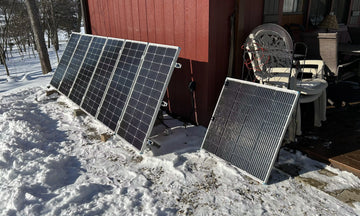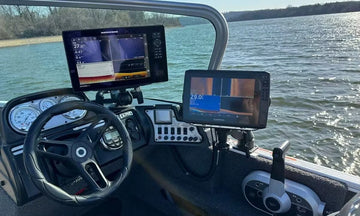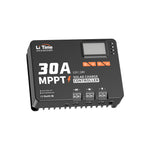
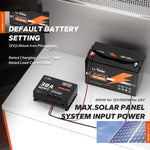
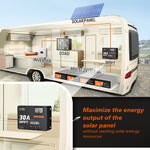
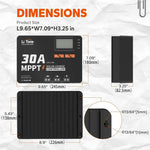
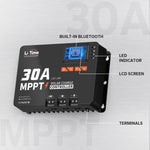
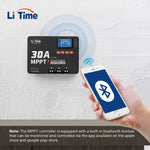

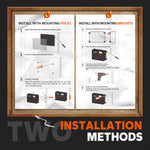

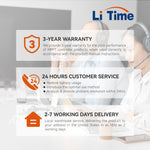


Total: $0.00






















【99% Tracking Technology】LiTime 30A MPPT Solar Charge Controller with advanced Maximum Power Point Tracking technology can continuously track array’s maximum power point so as to get the maximum amount of power to charge the battery. The tracking efficiency is not less than 99% and peak conversion efficiency is up to 98%.
【Bluetooth Function】 LiTime 12V/24V MPPT Controller equipped with a built-in Bluetooth module, customers do not need to purchase another Bluetooth module, which can achieve remote control and display usage information. Visit LiTime App download page for more details on downloading the app.
【LCD Screen & LED Indicators】LiTime MPPT controller comes equipped with an LCD screen to display the system operation information and 4 buttons to operate in the menus. Plus, multiple LED indicators will help to indicate the state of the solar panel array, battery, loads, controller.
【Excellent Heat Dissipation & Multiple Protections】LiTime MPPT controller is made of die-cast aluminum, which ensures excellent heat dissipation to reduce the power loss. In addition, the multiple protections built in the solar charge controller can ensure that the controller is completely protected from Reverse Connection, Overpower, Overvoltage, Short-circuit, and Over-temperature.
【Applicable to LiFePO4, Lead-acid Battery】LiTime 12V/24V 30A MPPT Solar Charge Controller’s default setting is for 12V LiFePO4 battery. But it’s also compatible for 24V LiFePO4 battery, Sealed, Gel Lead-acid batteries by adjusting the parameter.
【Additional Components】The copper wire connector equipped in the accessory can increase the contact area between the wire and MPPT during installation, increasing the ability to transmit current.












An MPPT (Maximum Power Point Tracking) charge controller optimizes the power output from your solar panels, increasing the efficiency of solar energy capture, especially in varying sunlight conditions.
The LiTime 12V/24V 30A MPPT Solar Charge Controller can work with standard off-grid 12/24V solar panels with high voltage or multiple panels with voltage up to 100V. And the maximum combined input solar power is 450W for a 12V battery system or 900W for a 24V system.
LiTime 12V/24V 30A MPPT Solar Charge Controller's default setting is for 12V LiFePO4 battery. But it's also compatible for 24V LiFePO4 battery, Sealed, Gel Lead-acid batteries by adjusting the parameters.
There is a practical limit though, if the solar array is too large then the power is just wasted, since the charge controller is always limiting the output. A typical recommendation is to limit the solar array to 110%-125% of the maximum controller rating.
LiTime solar charge controllers regulate the current from the panels to a safe level so it can charge the batteries. A 30A controller is adequate for a 300 watt solar panel set up.
LiTime solar charge controllers use maximum power point tracking (MPPT) technology which optimize solar production and control the battery charging voltage to prevent overcharging.
When the battery voltage reaches a point where the battery charger decides that the battery is full, the charger will cut out, and stop drawing power from the MPPT controller. In other words, the battery charger will present a high impedance to the MPPT controller.
No! MPPT solar charge controllers help to flow the current efficiently into your depleted battery. If we connect an MPPT solar charge controller directly to the inverter, your soalr system can get damaged, but if not damaged, there will be zero input in the inverter. So connecting MPPTs directly to the inverter is a bad idea!
You take the total watts of the solar array divided by the voltage of the battery bank. That will give you the output current of the soalr charge controller. For example, a 1000W solar array ÷ 24V battery bank = 41.6A. The rating of the charge controller should be at least 40A.
MPPT controllers are generally pricier compared to PWM controllers. However, they operate more efficiently under specific conditions, enabling them to generate more power using the same quantity of solar modules than a PWM controller.
I upgraded my Mppt controller on my sailboat to the Litime 30amp to match my Litime batteries with my solar array. Dang this thing works great. The app has worked better than expected. Victron is in some trouble I suspect. Litime you keep putting products out like this with great pricing and if longevity works out you have won my business.
LiTime 30A MPPT 12V/24V Solar Charge Controller Bluetooth integrated
LiTime is a great company with high quality products.
I recently upgraded to lithium batteries in my RV. The OEM solar controller made by F*unyun worked fine with lead acid batteries but with lithium it would reset to LA function every night when the controller went dormant. The next morning I would have to reset it to lithium mode again. Not so with the LiTime controller. It works flawlessly with my panels. Mounted easily, has a programmable dc load output, and shows what my system is doing via bluetooth. Hard to beat at this pricepoint.
Great controller best buy would buy again if needed Easy to set up.










